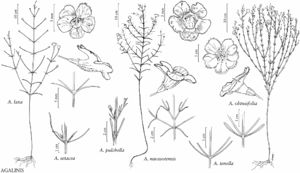Agalinis obtusifolia
New Fl. 2: 64. 1837.
Stems simple or branched, 30–80 (–100) cm; branches erect-ascending to arching-ascending, quadrangular, with siliceous ridges on angles and, often, faces proximal to leaves, glabrous, sometimes scabridulous on ridges and at nodes. Leaves erect to erect-ascending; blade linear-elliptic to narrowly spatulate, most widened distally, 10–20 x 0.4–1.5 mm, margins entire, adaxial surface scabrous; axillary fascicles absent. Inflorescences racemiform-paniculate, flowers 1 or 2 per node, interrupted by short multinoded branches bearing pseudoterminal flowers subtended by tiny bractlets; bracts shorter than pedicels. Pedicels spreading-ascending, 4–25 mm, glabrous, rarely scabridulous. Flowers: calyx hemispheric, tube 2–3 mm, glabrous, lobes deltate, 0.2–0.5 mm; corolla pink, with 2 yellow lines and pink spots pale or absent in abaxial throat, 12–15 (–17) mm, throat pilose externally and villous within across bases and sinus of adaxial lobes, lobes: abaxial spreading, adaxial reflexed-spreading, 3–5 mm, glabrous; proximal anthers parallel to filaments, distal perpendicular to filaments, pollen-sacs 1.5–2.1 mm; style exserted, 5–7 mm. Capsules globular to oblong, 4–5 mm. Seeds pale yellowish-brown, 0.6–0.8 (–1) mm. 2n = 26.
Phenology: Flowering Sep–late Oct.
Habitat: Mesic to dry savannas, dry roadsides with native vegetation, open rocky ground, open pine flatwoods, cutover and edges of pine plantations, margins of bogs and seepage slopes.
Elevation: 0–100 m.
Distribution
Ala., Del., Fla., Ga., Ky., La., Md., Miss., N.C., Pa., S.C., Tenn., Va.
Discussion
Agalinis obtusifolia is usually found in dry habitats and less frequently in more hydric conditions. The following suite of characters is useful for differentiating A. obtusifolia from A. decemloba, A. flexicaulis, and A. skinneriana: stems and branches stiffly erect, brittle, prominently siliceous-ridged, stramineous when dried; leaves obtusely and narrowly elliptic-spatulate, margins scabrous and revolute, stramineous when dried; calyx lobes minute and deltoid; corolla lacking internal markings or markings faint; and inflorescences of interrupted racemes with secondary and tertiary branches bearing pseudoterminal flowers. Characters useful for differentiating A. obtusifolia and A. tenella are discussed under 32. A. tenella.
F. W. Pennell (1929) used the name Agalinis erecta (J. F. Gmelin) Pennell for A. obtusifolia. Pennell based his combination on Anonymos erecta Walter, an invalid name.
Selected References
None.
